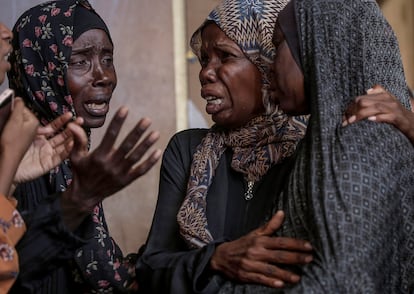Percentage of women killed in armed conflicts doubles in one year
The U.N. reports that in 2023, four out of 10 war fatalities were women, as civilian casualties surged due to conflicts like the Gaza offensive

Hekma Hamed Guma Khater remembers the exact moment her mother, Khadija Mustafa Osman Said, died at the age of 59. It was 6:29 p.m. on May 18, 2023, when their home in Nyala, South Darfur, was riddled with bullets during fighting between the Sudanese Armed Forces and the Rapid Support Forces paramilitaries. Her two brothers and a neighbor were also killed. Hekma, the sole survivor, sustained serious injuries to her eyes and arms. “My mother and my two brothers were killed in a cruel manner,” she recalls in a testimony collected by Amnesty International.
Khadija’s death last year is one that reflects a tragic statistic: 40% of civilians killed in armed conflict in 2023 were women, twice as many as in 2022. The number of children who lost their lives (30%) also tripled. The remaining 30% were adult men, according to U.N. Secretary-General António Guterres’ annual report on the protection of civilians in war contexts. This document also highlights an exponential increase in civilian casualties, with at least 33,443 non-combatants killed in 2023, a 72% rise from the previous year. The surge in fatalities is attributed to the outbreak of new armed conflicts, particularly the war in Gaza, where seven out of 10 deaths recorded by the U.N. occurred in occupied Palestine and Israel.
The increase in the proportion of women who died in armed conflict occurred “in all wars,” says Pablo Castillo, an expert from U.N. Women. This organization contributed to another report by Guterres on women, peace, and security, published in September, which highlights the alarming figures regarding female mortality in conflict zones.
“The reason [for this trend] is the growing disregard for international law and humanitarian standards amid a backdrop of both cold and hot wars between superpowers, along with a general geopolitical climate that challenges multilateralism,” says Castillo. “Additionally, there is a discernible trend of attacking anything that can be identified as feminism.”
This statement marks a shift in U.N. Women’s narrative, which typically focuses on stories of progress rather than portraying women as victims. “The situation has become so dire that we have had to go back to denunciation.”
“The world is caught in a frightening spiral of conflict, instability and violence. In 2023, more than 170 armed conflicts were recorded, and approximately 612 million women and girls lived within 50 km of these conflicts, 150% more than just a decade ago,” sates the U.N. report on women, peace and security.
Another “alarming” finding revealed by the study is the 50% increase in cases of sexual assault in conflict zones, along with a 35% rise in serious rape cases involving girls in these countries. This is emphasized by Cristina Sánchez, a law professor at the Autonomous University of Madrid and an expert on the intersection of war and gender. “These are not random acts; sexual violence is a targeted and effective weapon of war. It not only serves to displace populations from their homes but also functions as a bargaining chip, with women being sold among terrorist groups as a means of financing,” she explains.
The U.N. describes this situation as “a war on women,” noting that they are affected in numerous ways beyond death and rape. For instance, access to healthcare is becoming increasingly restricted. Every day, 500 women and girls in conflict-affected countries die from complications related to pregnancy and childbirth. “An estimated 52,000 pregnant women have been caught in the war, with an estimated 180 deliveries every day, most of them without access to anesthetics for cesarean sections and without water, sanitation, nutrition or postpartum care,” states the U.N. report.
“A pregnant patient from a rural area had to wait two days to get the money she needed to receive care,” says Maria Fix, head of the Doctors Without Borders team in South Darfur, Sudan. “When she finally reached a health center, they had no medicines, so she returned home. After three days, her condition worsened, but she again had to wait five hours to be transferred. She was in a coma when she reached us. She died of a preventable infection.”
Reports from medical NGOs that compile testimonies of these tragedies are numerous yet largely ignored by the international community. This criticism is explicitly highlighted in the Secretary-General’s document: “Even basic public awareness about these injustices is lacking.” The report also criticize the lack of media coverage: although reports on wars increased sixfold between 2013 and 2023, only 5% focused on women’s experiences, and a mere 0.04% mentioned women’s contributions as leaders.
“In the Democratic Republic of the Congo, the use of sexual violence as a weapon of war has been denounced for decades. And nothing happens. This also sends a message of impunity,” says Sánchez. In that country, the U.N. reported over 123,000 cases of gender violence in 2023, a 300% increase over three years, which has not been accompanied by a rise in convictions. Indeed, it was a milestone when, in May of that year, a Congolese court convicted a militia leader for the crime of forced pregnancy for the first time in the world.
Gender ‘apartheid’
The neglect is also evident in the reduced funding for organizations focused on gender equality and specific programs aimed at mitigating the impact of war on women, the document states.
Women are frequently excluded from peace negotiations, “despite the fact that it is known that increased female participation leads to more robust and lasting agreements,” notes Castillo from U.N. Women. “In 2023, diplomacy saw little success, with women largely sidelined from processes,” he adds. Women comprised only 9.6% of negotiators, 13.7% of mediators, and 26.6% of signatories of peace and ceasefire agreements. This proportion drops to a mere 1.5% when the Colombia peace agreements are excluded.
Instead of progress, attacks against women’s rights activists have intensified. “Anti-gender and anti-feminist movements are well-organized and have at their disposal considerable financial resources,” says the report. In several countries, including Iraq, Libya, and Yemen, local or national authorities have even banned the term “gender” and restricted or persecuted activities advocating for equality. “This crackdown on gender-related work is accompanied by increasing attacks against women human rights defenders, as well as women journalists and artists in conflict-affected settings,” it adds.
In Afghanistan, “the oppression of Afghan women is severe,” the report continues. Girls over the age of 12 have been denied the right to education for three years, among various other restrictions that have led the U.N. to classify the situation as gender apartheid. In surveys conducted by U.N. Women, the International Organization for Migration, and the United Nations Assistance Mission in Afghanistan, 82% of respondents rated their mental health as poor or very poor, and 8% reported knowing at least one woman or girl who had attempted suicide since August 2021.
“Women continue to pay the price of the wars of men,” said U.N. Women Executive Director Sima Bahous in a statement following the release of the report. “If we do not stand up and demand change, the consequences will be felt for decades, and peace will remain elusive.”
Sign up for our weekly newsletter to get more English-language news coverage from EL PAÍS USA Edition
Tu suscripción se está usando en otro dispositivo
¿Quieres añadir otro usuario a tu suscripción?
Si continúas leyendo en este dispositivo, no se podrá leer en el otro.
FlechaTu suscripción se está usando en otro dispositivo y solo puedes acceder a EL PAÍS desde un dispositivo a la vez.
Si quieres compartir tu cuenta, cambia tu suscripción a la modalidad Premium, así podrás añadir otro usuario. Cada uno accederá con su propia cuenta de email, lo que os permitirá personalizar vuestra experiencia en EL PAÍS.
¿Tienes una suscripción de empresa? Accede aquí para contratar más cuentas.
En el caso de no saber quién está usando tu cuenta, te recomendamos cambiar tu contraseña aquí.
Si decides continuar compartiendo tu cuenta, este mensaje se mostrará en tu dispositivo y en el de la otra persona que está usando tu cuenta de forma indefinida, afectando a tu experiencia de lectura. Puedes consultar aquí los términos y condiciones de la suscripción digital.
More information
Archived In
Últimas noticias
Most viewed
- Reinhard Genzel, Nobel laureate in physics: ‘One-minute videos will never give you the truth’
- Oona Chaplin: ‘I told James Cameron that I was living in a treehouse and starting a permaculture project with a friend’
- Pablo Escobar’s hippos: A serious environmental problem, 40 years on
- Why we lost the habit of sleeping in two segments and how that changed our sense of time
- Chevy Chase, the beloved comedian who was a monster off camera: ‘Not everyone hated him, just the people who’ve worked with him’











































